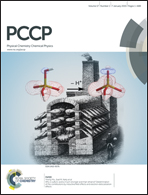Spin-crossover in phenylazopyridine-functionalized Ni–porphyrin: trans–cis isomerization triggered by π–π interactions†
Abstract
Reversible, room-temperature light-induced spin-crossover has been reported in a Ni–porphyrin functionalized with a phenylazopyridine (PAPy) ligand (Venkataramani et al., Science, 2011, 331, 445). Upon light irradiation (500 nm), the azopyridine moiety induces a change in the Ni(II) coordination sphere from square planar (n = 4) to square pyramid (n = 5), leading to a change in the total spin of the molecule from S = 0 to S = 1. The trans–cis isomerization in the azopyridine ligand has been proposed to trigger the spin-crossover effect. However, the radiation used to induce the HS state is about 135 nm red-shifted with respect to the radiation used for trans–cis isomerization of the N![[double bond, length as m-dash]](https://www.rsc.org/images/entities/char_e001.gif) N double bond in other compounds. To elucidate the light-induced spin-crossover mechanism of this Ni(II) compound, a combined DFT/CASSCF/CASPT2 study has been performed to determine the most stable cis and trans conformers with n = 4 or n = 5, and to characterize the excitation that triggers the SCO process. π–π interactions between porphyrin and PAPy are shown to play an essential role in the spin crossover.
N double bond in other compounds. To elucidate the light-induced spin-crossover mechanism of this Ni(II) compound, a combined DFT/CASSCF/CASPT2 study has been performed to determine the most stable cis and trans conformers with n = 4 or n = 5, and to characterize the excitation that triggers the SCO process. π–π interactions between porphyrin and PAPy are shown to play an essential role in the spin crossover.


 Please wait while we load your content...
Please wait while we load your content...